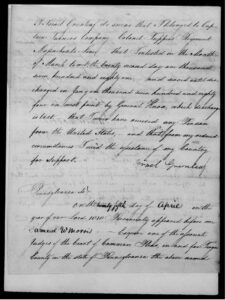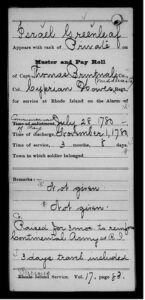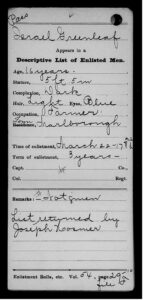Applying to a lineage society can be a complicated process, especially if you are applying under a new ancestor or an ancestor with known problems in their lineage. Receiving a rejection letter after submitting such a lineage can make the process feel frustrating if you know the line is right. Sometimes the society will see problems that the applicant does not, or they know that with just the right piece of evidence the line would be acceptable without a problem. A rejection, however, is not always an insurmountable loss. Sometimes, if you look at the sources in question and do some diligent research, you can convince the lineage society that they are mistaken and have your application accepted.
This was the case with an application I worked on with a patriot named Israel Greenleaf. The Sons of the American Revolution had rejected an application using him as an ancestor because they believed that the service for Israel Greenleaf had been attributed to another individual with the same name. The primary source of this information was A Genealogy of the Greenleaf Family by Jonathan Greenleaf, which has two entries for two different patriots, father and son, named Israel Greenleaf. War service being misattributed or mixed with two different ancestors is a fairly common reason that a lineage society might reject an application. Sometimes records do not exist to resolve the dilemma; at other times the right information exists to make an argument that clarifies the identity and service of each person. This was the case with Israel Greenleaf.
Untangling this web first required examining the source material for the Greenleaf genealogy, which were the Massachusetts Revolutionary War Muster Rolls. These muster rolls are organized alphabetically on popular genealogy sites like FamilySearch and fold3. I examined the Israel Greenleaf section of this muster roll and found that two separate service periods had been attributed to one person. Within the same person’s muster roll, we had the following documents:
Rank: Private
Company leader: Capt. Thomas Brintnall
Regiment leader: Col. Cyprian Howes (Middlesex co.)
Time of enlistment: 28 July 1780
Time of discharge: 1 November 1780
Time of Service: 3 months 8 days
Time of enlistment: 22 March 1781
Time of service: 3 years
Age at service: 16 years
Typically, you will see several different muster cards for any one person. What made this one suspicious, however, is that the second person was 16 at the time of his first enlistment, which began 22 March 1781. This was considered the minimum age at which someone could serve in the Revolutionary War. This suggested that the first muster card belonged to a different Israel Greenleaf, since his service began in 1780, when the second Israel Greenleaf would have been 15.
Additional documents in the muster roll include pension applications in which the applicant recalls their service to the War Department. The pension, in this case, was the smoking gun that proved that the Israel Greenleaf in this muster roll packet contained the service of two different people. The younger Israel Greenleaf stated in his pension:
“I Israel Greenleaf do swear that I belonged to Captain Turners Company – Colonel Tuppers Regiment Massachusetts Line – that I enlisted in the Month of March to wit; the twenty second day one thousand seven hundred and eighty one – and served until discharged in January one thousand seven hundred and eighty four.”
In applying for his pension, Israel would have included the totality of his time served in the war. This information demonstrates that he began his service on 22 March 1781, and did not serve before that. This means that the previous service must belong to his father, Israel Greenleaf.
By closely examining the muster roll packet for Israel Greenleaf, we learned that the documents within actually pertained to two separate people. This would not have been evident to SAR when they reviewed the muster roll as part of their application process, since they appear as one person’s materials. A deeper dive, however, revealed that this muster roll was assembled and digitized in such a way that assumed that the documents belonged to the same person, and this was not the case.
In the end, SAR ended up changing their decision on this particular application because they saw the same issues with the muster roll after they were pointed out for them. It can seem like an overwhelming obstacle when your lineage application is rejected by the society on one basis or another. Understanding the problem and careful research, however, can sometimes correct the decision.
Sources
James Edward Greenleaf, Genealogy of the Greenleaf Family (Boston: Frank Wood, Printers, 1896).
Israel Greenleaf, “Massachusetts, Revolutionary War, Index Cards to Muster Rolls, 1775-1783,” GS Film Number 002026996, viewed on FamilySearch.org.
Share this:

About Raymond Addison
Raymond earned his BA in History from Stonehill College. During his time there he worked as an archivist's aide. He took roles in digitizing record collections and in preserving and restoring 19th century business ledgers. Prior to working with NEHGS, he worked with the Cambridge Public Library as a circulation librarian. He began studying his own genealogy as a hobby and quickly started showing library users how they could explore the field for themselves. In addition to his genealogical interests, Raymond enjoys being active in his free time and is an avid tennis player.View all posts by Raymond Addison →


